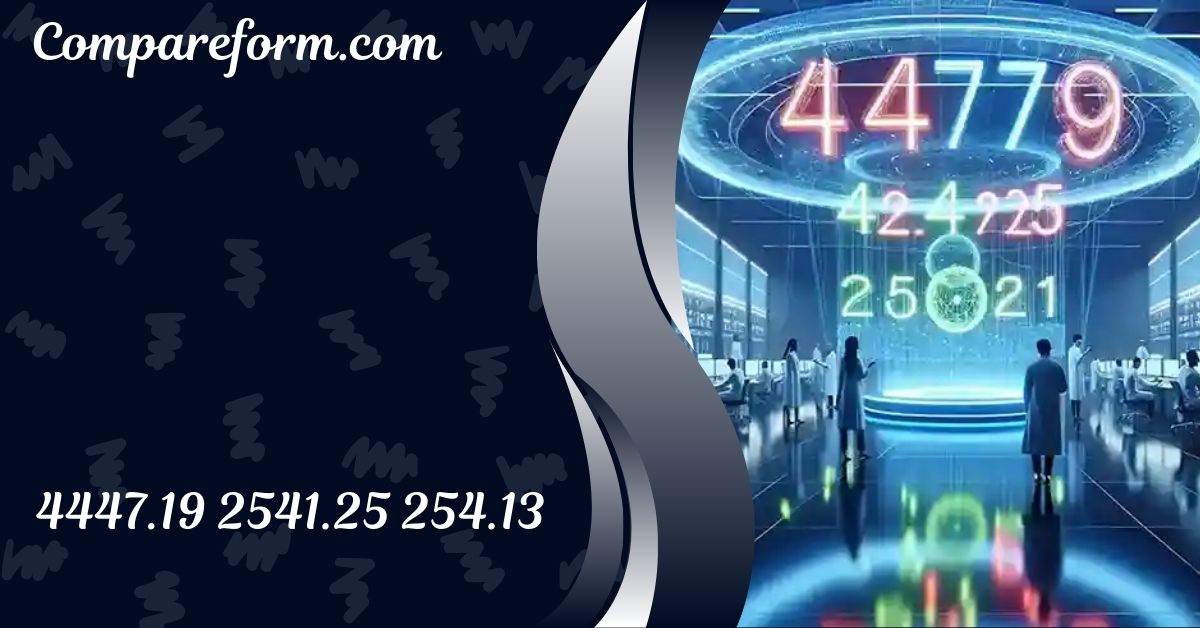4447.19 2541.25 254.13 – The Numerical Sequence
The sequence “4447.19 2541.25 254.13” is a captivating set of numbers that extends beyond its superficial appearance. With various applications in mathematics, computer science, data analysis, and numerous other fields, this trio of numbers embodies significant properties and potential uses. This comprehensive article will delve into the mathematical attributes of these numbers, their historical context, and their practical applications.
Introduction to 4447.19 2541.25 254.13
The numerical sequence “4447.19 2541.25 254.13” is more than just a collection of digits; it reflects intricate relationships and applications that span various fields. Each number holds unique mathematical properties and collective characteristics that can significantly influence data processing and analysis.
The significance of this sequence can be understood through its components:
- 4447.19: This number stands out due to its length and decimal component, making it useful in various precise calculations.
- 2541.25: A balanced number that can represent averages or totals in data sets.
- 254.13: A smaller yet pivotal number that might represent margins or specific metrics in calculations.
As we explore this article, we will unveil the layers of complexity behind these numbers and how they can impact different sectors, especially in the United States.
Mathematical Properties of the Sequence
Rational and Irrational Numbers
To understand the sequence “4447.19 2541.25 254.13,” we must first classify the numbers as rational or irrational. A rational number can be expressed as a fraction of two integers, while an irrational number cannot be expressed in such a manner.
- 4447.19: This number is rational because it can be expressed as 444719100\frac{444719}{100}100444719.
- 2541.25: Similarly, this number is rational, represented as 254125100\frac{254125}{100}100254125.
- 254.13: This number is also rational, represented as 25413100\frac{25413}{100}10025413.
This property is essential in mathematical computations, particularly when performing operations that involve fractions or decimals.
Prime Factorization and Divisibility
Prime factorization involves breaking down a number into its prime constituents. Understanding this can help in simplifying fractions or solving equations.
- Prime Factorization:
- 4447: Not a prime number; it can be factored into 13×34313 \times 34313×343.
- 2541: This is also not a prime number and can be expressed as 3×8473 \times 8473×847.
- 254: This number can be factored into 2×1272 \times 1272×127.
Exploring these factors allows mathematicians and data analysts to understand divisibility and common multiples, which can be vital in simplifying data sets or algorithms.
Relationships Between the Numbers
The relationship between the numbers can be analyzed in various ways:
- Proportional Relationships: Understanding how these numbers relate to each other can inform statistical analysis.
- Patterns and Trends: Analysts can observe patterns when these numbers are used in data sets, leading to predictive modeling.
Historical Context of Numerical Sequences
Evolution in Mathematics
The development of numerical sequences has been a fundamental aspect of mathematics. Early mathematicians like Euclid and Pythagoras explored numerical properties, laying the groundwork for understanding complex number sequences.
As we entered the modern era, the significance of numbers like “4447.19 2541.25 254.13” became apparent, especially with the advent of technology and data analytics.
The Role of Numbers in Computer Science
Computer science has extensively utilized numerical sequences. The binary system, algorithms, and data structures often rely on numerical properties to perform efficiently. The use of floating-point numbers, such as those in our sequence, is essential for calculations in programming, simulations, and artificial intelligence.
Applications of 4447.19 2541.25 254.13
Data Analysis
In the field of data analysis, numerical sequences play a crucial role. The numbers “4447.19 2541.25 254.13” can be utilized to represent:
- Metrics: Average, median, or total values in a data set.
- Statistical Testing: Used in hypothesis testing to derive conclusions about a population.
Data analysts can leverage these numbers to summarize complex datasets and derive meaningful insights.
Cryptography
Cryptography relies heavily on numerical sequences for encoding and decoding information. The properties of the numbers in our sequence can contribute to the creation of secure encryption algorithms, ensuring the confidentiality of data.
Financial Modeling
In finance, numbers like “4447.19 2541.25 254.13” can represent critical figures, such as:
- Stock Prices: Tracking changes in market value.
- Revenue Figures: Summarizing financial performance over time.
The mathematical properties of these numbers aid financial analysts in modeling and forecasting economic trends.
Complex Computations with the Sequence
Statistical Analysis
Statistical methods often require precise calculations, and the numbers in our sequence can be utilized in various statistical techniques:
- Regression Analysis: To identify trends and make predictions.
- ANOVA: To compare means across different groups.
Algorithm Development
Algorithms rely on numerical sequences for processing information. The sequence “4447.19 2541.25 254.13” can inform algorithmic design in machine learning and artificial intelligence, optimizing data processing.
Real-World Examples of the Sequence
Case Studies
- Healthcare: Using the sequence in data analysis to track patient outcomes and treatment effectiveness.
- Retail: Analyzing sales data to derive insights on consumer behavior.
User Experiences
Many professionals across sectors have found value in understanding numerical sequences like “4447.19 2541.25 254.13.” For example, data scientists report improved analysis efficiency when incorporating these numbers into their models.
Frequently Asked Questions (FAQs)
What does the sequence “4447.19 2541.25 254.13” represent?
This sequence represents a set of rational numbers that have significant mathematical properties and applications in various fields, including data analysis, computer science, and finance.
How can these numbers be applied in real-world scenarios?
These numbers can be used in statistical analyses, financial modeling, cryptography, and as part of algorithms in machine learning and artificial intelligence.
Why are rational numbers important in mathematics?
Rational numbers are essential because they can be expressed as fractions, making them useful in precise calculations and analyses across various mathematical applications.
Conclusion: The Significance of 4447.19 2541.25 254.13
In conclusion, the numerical sequence “4447.19 2541.25 254.13” transcends its basic representation. It embodies mathematical principles, historical significance, and practical applications that resonate across multiple fields. As we continue to explore the intricate nature of numbers, the potential uses of such sequences will undoubtedly expand, influencing the way we analyze and process data in our increasingly digitized world.






